Related Research Articles

The Wise Little Hen is a 1934 Walt Disney's Silly Symphony cartoon, based on the fable The Little Red Hen. The cartoon features the debut of Donald Duck, dancing to "The Sailor's Hornpipe". Donald and his friend Peter Pig try to avoid work by faking stomach aches until Mrs. Hen teaches them the value of labor.
Silly Symphony is an American animated series of 75 musical short films produced by Walt Disney Productions from 1929 to 1939. As the series name implies, the Silly Symphonies were originally intended as whimsical accompaniments to pieces of music. As such, the films usually did not feature continuing characters, unlike the Mickey Mouse shorts produced by Disney at the same time. The series is notable for its innovation with Technicolor and the multiplane motion picture camera, as well as its introduction of the character Donald Duck making his first appearance in the Silly Symphony cartoon The Wise Little Hen in 1934. Seven shorts won the Academy Award for Best Animated Short Film.
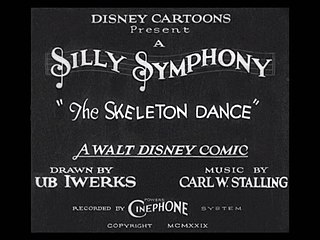
The Skeleton Dance is a 1929 Silly Symphony animated short subject produced and directed by Walt Disney and animated by Ub Iwerks. In the film, four human skeletons dance and make music around a spooky graveyard—a modern film example of medieval European "danse macabre" imagery. It is the first entry in the Silly Symphony series. In 1993, to coincide with the opening of Mickey's Toontown in Disneyland, a shortened cover of the cartoon's music was arranged to be featured in the land's background ambiance. The short's copyright was renewed in 1957, and as a published work from 1929 it will enter the US public domain on January 1, 2025.
Elmer Elephant is a Silly Symphony cartoon short produced by The Walt Disney Company, directed by Wilfred Jackson and released on March 28, 1936.
The first wave of Walt Disney Treasures was released on December 4, 2001. It includes four different DVD sets.
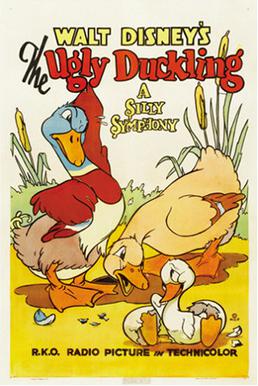
The Ugly Duckling is a 1939 animated short film by Walt Disney, based on the 1843 fairy tale "The Ugly Duckling" by Hans Christian Andersen. The film was directed by Jack Cutting and Clyde Geronimi, and released in theaters on April 7, 1939. Music was composed by Albert Hay Malotte, who was uncredited for the film. The animated short was first distributed by RKO Radio Pictures, and was shown with Love Affair.
The Ugly Duckling is an animated black-and-white cartoon released by Walt Disney in 1931 as part of the Silly Symphonies series. This cartoon was later remade into a color version released in 1939. About eight years later, in 1939, the film would be remade and would follow the original Andersen story much more faithfully. This gives The Ugly Duckling the unique distinction of being the only Silly Symphony to be made twice. This film was then sold to reach about 4,000 dollars per month at the most profit, because it slowly climbed up the scale of growth.

The Pied Piper is a 1933 American Pre-Code animated short film based on the story of the Pied Piper of Hamelin. The short was produced by Walt Disney Productions, directed by Wilfred Jackson, and released on September 16, 1933, as a part of the Silly Symphonies series.

Ferdinand the Bull is a 1938 American stand-alone animated short produced by Walt Disney Productions and released on November 25, 1938, by RKO Radio Pictures. It was directed by Dick Rickard and based on the 1936 book The Story of Ferdinand by Munro Leaf. The music was by Albert Hay Malotte, most known for his setting of The Lord's Prayer, commonly sung at weddings.

The Grasshopper and the Ants is a 1934 American animated short film produced by Walt Disney Productions and released by United Artists. Part of the Silly Symphonies series, the film is an adaptation of The Ant and the Grasshopper, one of Aesop's Fables. It was directed by Wilfred Jackson and stars Pinto Colvig as the voice of the grasshopper "Hop."

The Flying Mouse is a 1934 Silly Symphonies cartoon produced by Walt Disney, directed by David Hand, and released to theatres by United Artists on July 14, 1934. The use of color here was rather innovative as it is set during the course of a single day.
Birds of a Feather is a Silly Symphonies animated Disney short film. It was released on February 10, 1931, by Columbia Pictures.
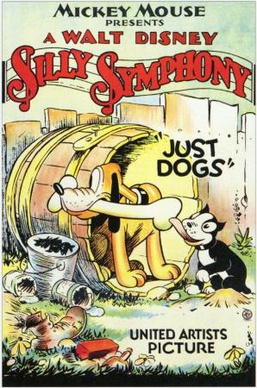
Just Dogs is a 1932 animated film part of the Silly Symphony series, directed by Burt Gillett. It marked the first solo appearance of Pluto.
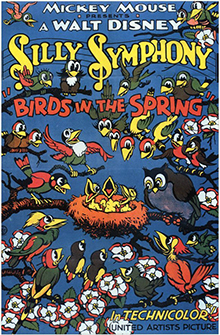
Birds in the Spring is a Silly Symphonies animated Disney short film. It was released in 1933.

Peculiar Penguins is a Silly Symphonies animated Disney short film. It was released in 1934.

The Goddess of Spring is a 9-minute Silly Symphonies animated Disney short film. The Symphony is imbued with operatic themes and is often cited as melodramatic. It was released in 1934, and its production was important to the future development of Disney's Snow White and the Seven Dwarfs animation. Each Silly Symphony was a technological marvel at the time and proceeded to further advancements in the animation industry.

Cock o' the Walk is a Silly Symphonies animated Disney short film. It was released in 1935.

Farmyard Symphony is a 1938 Silly Symphonies animated short film. It can be seen as a precursor to Fantasia due to using various pieces of classical music in one short. The film was directed by Jack Cutting and produced by Walt Disney.
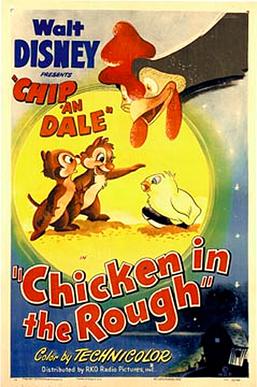
Chicken in the Rough is a 1951 animated short starring Chip 'n' Dale. It is Chip 'n' Dale's first solo cartoon, and footage is reused from Farmyard Symphony. In the short film, Chip 'n' Dale wander into a farmyard to collect acorns. Dale mistakes an egg for a nut, but when he tries to demonstrate to a newly hatched chick how to get back into the egg, a rooster mistakes him for one of his chicks, much to Chip's amusement.
Silly Symphony, initially titled Silly Symphonies, was a weekly Disney comic strip that debuted on January 10, 1932, as a topper for the Mickey Mouse strip's Sunday page. The strip featured adaptations of Walt Disney's popular short film series, Silly Symphony, which released 75 cartoons from 1929 to 1939, as well as other cartoons and animated films. The comic strip outlived its parent series by six years, ending on October 7, 1945.
References
- 1 2 Merritt, Russell; Kaufman, J. B. (2016). Walt Disney's Silly Symphonies: A Companion to the Classic Cartoon Series (2nd ed.). Glendale, CA: Disney Editions. pp. 184–185. ISBN 978-1-4847-5132-9.
- ↑ Taliaferro, Al; Osborne, Ted; De Maris, Merrill (2016). Silly Symphonies: The Complete Disney Classics, vol 2. San Diego: IDW Publishing. ISBN 978-1631408045.
- ↑ "Silly Symphonies: The Historic Musical Animated Classics DVD Review". DVD Dizzy. Retrieved 20 February 2021.